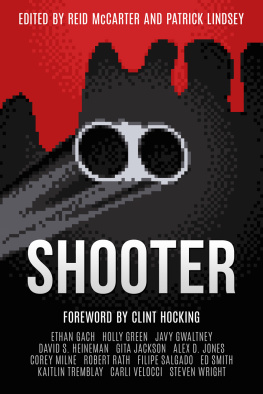APPROACHES TO DIGITAL GAME STUDIES
Volume 2
Series Review Board
(Alphabetically)
Mia Consalvo, Concordia University, Montreal
James Paul Gee, Arizona State University
Helen Kennedy, University of the West of England
Frans Myr, University of Tampere
Toby Miller, University of California, Riverside
Torill Mortensen, IT University Copenhagen
Lisa Nakamura, University of Illinois
Gareth Schott, University of Waikato
Mark J. P. Wolf, Concordia University, Wisconsin
Series Editors
Gerald Voorhees, Oregon State University
Josh Call, Grand View University
Katie Whitlock, California State University, Chico
S hotgun? Check. Armor? Check. Plenty of rounds? Check. Blue key? No? Well, youll have to wander around until you find it then. We know this scenario well. Were armed to the teeth, carrying seven different guns (one of which is always a shotgun). We have a metric ton of ammunition, and for once were not riddled with bullet holes, bite marks, plasma burns, and a veritable cornucopia of other unpleasant injuries (no tele-fragging just yet!). We have slowly, painstakingly, obliterated every single armed menace possessed of the grave misfortune to cross our path. We have thoroughly redefined the idea of collateral damage, and completely disregarded all rhetoric of proportional response. And now we are at the end of it all, staring down the gun-sights of success, fame, glory, and an epic stomping of whatever monstrosity orchestrated all this madness to begin with (because we certainly didnt start things). But here we are held up because we cant unlock the door. Thus goes a day in the life of the FPS player.
If the above description seems a bit extreme, almost silly, then its well placed. As a game genre the history of the FPS is written in an excess that has gradually tempered over time. In each of the examples above we could imagine a multitude of titles that employ those conventions and experiences as a function of the gameplay. Readers will, we hope, forgive us the Blue key reference to DOOM (id Software 1993), which seemed to particularly delight in forcing players to continuously re-navigate level maps hunting the one key that stands between the player and progress. The early FPS genre of the late 1980s and early 1990s was built on a formula, both ludic and mechanistic. It was a recipe for success invented largely on the back of id Softwares now legendary DOOM. From those formulaic and humble beginnings, the contemporary FPS game has evolved.
And it has evolved in numerous, divergent directions, some of which have converged in interesting configurations. Now, you are just as likely to find yourself running and gunning your way across a historical battlefield or a contemporary Middle-Eastern city as you are a space station or Martian research facility. You are almost as likely to find yourself tactically considering how to move without breaking cover, with the aid of a helpers suppressive fire, to assault a fortified position. Perhaps one of those weapons youre carrying is a crossbow or a M1 Garand or a plasma rifle. Or, maybe, in a small nod to realism, youre limited to two weapons. Dont worry, youll still have access to a shotgun. Are you wearing a uniform? Are you cybernetically augmented? Can you conjure supernatural powers? How you answer these questions speaks to what path youve followed in the evolution of the FPS.
Delimiting the FPS
No doubt due in part to its thematic and ludic diversity, the genre is arguably the most popular at the moment. And given the centrality of guns and combat, it is one of the most frequently discussed genres. Policy advocates and social crusaders discourse endlessly about the FPS. And academics have given FPS games more attention than any other single game genre.
Despite all of the scholarship concerning FPS games, as yet no one has endeavored to do more than crudely sketch the contours of the genre. As if it were a commonplace, the FPS is typically described in a sentence or two. Even Aki Jrvinens (2002) short essay/game review of Halo: Combat Evolved (Bungie 2001), Anatomy of the FPS, does little to help familiarize readers with the morphology of the genre. After a brief discussion of the status of genre in game studies, Jrvinen claims that Halo does everything a little bit better than its predecessors hitting the FPS genre with a new high. Jrvinen goes on to discuss Halos cutscenes, movement, sound, destructible environments and control scheme, but neither claims that this set of elements sufficiently defines the genre nor attempts to explain in what configurations sound or controller layouts are representative of the FPS as a genre. And while one might assume Galloways (2006) Origins of the First-Person Shooter would have something to say about the essential qualities characteristic of the genre, that assumption is incorrect; Galloway is concerned almost entirely with the visual spectacle of the FPS. The same might be said of Morriss (2002) First-Person Shooters A Game Apparatus. However, borrowing the construct of the apparatus from film theory, Morris is less concerned with the FPS as a game genre constituted by specific formal structures as she is with describing the intersecting processes involved in audience interaction with a media form (81). This flippant treatment of the genre is not uncommon, however, of scholarly treatments of the FPS.
The few detailed considerations of the FPS we have tend to focus on one or another quality of the genre at the expense of the composite image. In order to further theorize immersion, for instance, Grimshaw, Charlton, and Jagger (2011) consider narrative, spatial, visual, and auditory elements of the FPS, but only insofar as they organize the players attention and contribute to immersion. Grimshaw and Schott (2008) examine the acoustic ecology of FPS games in an effort to map how sound is imbricated in the play experience. More attention has been paid, however, to the visual and aesthetic character of the FPS. While Lahati (2003) and Morris (2002) attend to the importance of the FPSs representation of three-dimensional space, Slocombe (2005) and Jones (2008) theorize the relationship between the first-person perspective and player immersion in the gameworld, and Morris (2002) and Rehak (2003) consider how the first-person perspective impacts player identification with player-characters. Of course, while this research does enable interested scholars to reflect on the properties characteristic of the FPS and will, in the pages that follow, be put to this very use, it does not identify the constitutive elements of the genre.
What, then, are the essential components of an FPS? In what follows, we identify the distinctive features constitutive of the FPS, the elements that players, developers, designers, critics, and scholars expect in an FPS. We arrive at this conclusion aided by the foresight of others who have ventured to define the FPS, but in so doing note the same problem mentioned above: the FPS is a taken-for-granted form. Game reviews praise or blame one title or another for giving or failing to give fans of the genre everything they have come to expect of an FPS without enumerating what those expectations are; interviews in gaming magazines and on












